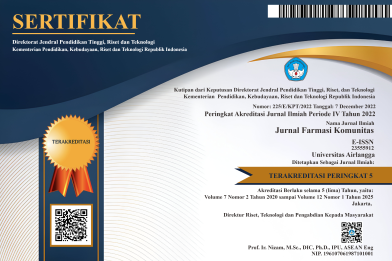Identifikasi Hubungan Pengetahuan, Sikap, dan Perilaku Merokok pada Anak di Bawah Umur di Indonesia
Downloads
Merokok merupakan kebiasaan buruk yang menjadi masalah kesehatan masyarakat yang berujung pada kematian dini. Selain itu, merokok sangat erat kaitannya dengan berbagai penyakit neurologis, kardiovaskular, dan paru. Perilaku merokok dapat dipengaruhi oleh beberapa faktor, seperti pengetahuan, sikap, dan lingkungan sosial. Penelitian ini bertujuan untuk mengetahui pengetahuan, sikap, dan perilaku merokok pada anak di bawah umur di Indonesia. Responden dipilih berdasarkan kriteria inklusi yaitu anak usia 13-17 tahun, perokok aktif baik rokok tembakau maupun rokok elektrik, masih merokok sampai dilakukan pendataan, dan berdomisili di Indonesia. Penelitian ini menggunakan desain penelitian cross-sectional dengan menggunakan kuesioner online terstruktur yang telah divalidasi. Hasil responden selanjutnya dianalisis untuk mengetahui hubungan antara pengetahuan, sikap, dan praktik menggunakan analisis korelasi Spearman. Terdapat 90 responden pada penelitian ini. Mayoritas responden berusia 17 tahun (55,56%) dan berjenis kelamin laki-laki (77,78%). Rentang usia termuda responden mulai merokok adalah 5-10 tahun (10%). Hasil penelitian menunjukkan bahwa tidak ada hubungan antara masing-masing variabel pengetahuan, sikap, dan perilaku merokok. Edukasi terkait bahaya merokok harus terus dilanjutkan, terlebih pada perokok di bawah umur.
Agaku, I. T., Sigh, T., Jones, S. E., King, B., Jamal, A., Neff, L., & Caraballo, R.S. (2015) ‘Combustible and smokeless tobacco use among High School Athletes in United States.', Morbidity and Mortality Weekly Report, 64(34), pp. 935–939.
Bigwanto, M., Mongkolcharti, A., Peltzer, K., & Laosee, O.(2015) ‘Determinants of cigarette smoking among school adolescents on the island of Java, Indonesia', International Journal of Adolescent Medicine and Health, 29(2), pp. 1–8. doi: 10.1515/ijamh-2015-0036.
Browne, M., & Todd, D. G. (2018) ‘Then and now: Consumption and dependence in e-cigarette users who formerly smoked cigarettes.', Addictive Behaviors, 76, pp. 113–121. doi: 10.1016/j.addbeh.2017.07.034.
Farsalinos, K. (2018) ‘E-cigarettes: An aid in smoking cessation, or a new health hazard?.', Therapeutic Advances in Respiratory Disease, 12, pp. 1–20. doi: 10.1177/1753465817744960.
Griesler, P. C., Hu, M. C., & Kandel, D. B. (2016) ‘Nicotine dependence in adolescence and physical health symptoms in early adulthood.', Nicotine and Tobacco Research, 18(5), pp. 950–958. doi: 10.1093/ntr/ntv149.
Hammond, D., Reid, J. L., Cole, A. G., & Leatherdale, S. T. (2017) ‘Electronic cigarette use and smoking initiation among youth: a longitudinal cohort study.', Canadian Medical Association Journal, 189(43), pp. 1328–1336. doi: 10.1503/cmaj.161002.
Jankowski, M., Brozek, G., Lawson, J., Skoczynski, S., & Zejda, J. E. (2017) ‘E-smoking: Emerging public health problem?.', International Journal of Occupational Medicine and Environmental Health, 30(3), pp. 329–344. doi: 10.13075/ijomeh.1896.01046.
Kementerian Kesehatan RI (2018) Hasil Utama Riset Kesehata Dasar (RISKESDAS) 2018, Badan Penelitian dan Pengembangan Kesehatan.
Menteri Pendidikan dan Kebudayaan RI (2015) Peraturan Menteri Pendidikan dan Kebudayaan Republik Indonesia Nomor 64 Tahun 2015 tentang Kawasan Tanda Rokok di Linkungan Sekolah.
Merianos, A. L., & Mahabee-Gittens, E. M. (2020) ‘Screening, counseling, and health care utilization among a national sample of adolescent smokers.', Clinical Pediatrics, 59(4–5), pp. 467–475. doi: 10.1177/0009922820905875.
Muzakkir. (2017) ‘Trend of smoking behavior and the social impact on adolescents at Makassar in Indonesia.', International Journal of Current Research in Biosciences and Plant Biology, 4(3), pp. 33–40. doi: 10.20546/ijcrbp.2017.403.004.
Notoatmodjo, S. (2010) Ilmu Perilaku Kesehatan. Jakarta: Rineka Cipta.
Pandayu, A., Murti, B., & Pawito (2017) ‘Effect of Personal factors, family support, pocket money, and peer group, on smoking behavior in adolescents in Surakarta, Central Java.', Journal of Health Promotion and Behavior, 2(2), pp. 98–111. doi: 10.26911/thejhpb.2017.02.02.01.
Pemerintah Indonesia (1999) Peraturan Pemerintah Republik Indonesia Nomor 81 Tahun 1999 Tentang Pengamanan Rokok Bagi Kesehatan.
Pemerintah Indonesia (2012) Peraturan Pemerintah (PP) Nomor 102 Tahun 2012 Tentang Pengamanan Bahan yang Mengandung Zat Adiktif Berupa Produk Tembakau Bagi Kesehatan.
Ramachandran, S., Bentley, S., Casey, E., & Bentley, J. P.(2020) ‘Prevalence of and factors associated with violations of a campus smoke-free policy: a cross-sectional survey of undergraduate students on a university campus in the USA.', BMJ Open, 10(3), pp. 1-10. doi: 10.1136/bmjopen-2019-030504.
Romero, E., Domínguez, B., & Castro, M. A. (2017) ‘Predicting smoking among young people: Prospective associations from earlier developmental stages.', Revista de Psicología Clínica Con Niños y Adolescentes, 4(2), pp. 119–127.
United States Department of Health and Human Services (2020) Smoking Cessation: A Report of the Surgeon General, National Center for Chronic Disease Prevention and Health Promotion.
World Health Organization (2015) Global Youth Tobacco Survey (GYTS): Indonesia report 2014, Indonesia Report.
World Health Organization (2018) Fact Sheet 2018: Indonesia, Who.
Xu, X., Lui, L., Sharma, M., & Zhao, Y. (2015) ‘Smoking-related knowledge, attitudes, behaviors, smoking cessation idea and education level among young adult male smokers in Chongqing, China.', International Journal of Environmental Research and Public Health, 12(2), pp. 2135–2149. doi: 10.3390/ijerph120202135.
Copyright (c) 2022 Jurnal Farmasi Komunitas

This work is licensed under a Creative Commons Attribution-NonCommercial-ShareAlike 4.0 International License.
In order to be accepted and published by JFK, author(s) submitting the article manuscript should complete all the review stages. By submitting the manuscript, the author(s) agreed to these following terms:
1. Copyright of the article is transferred to the journal (JFK), by the knowledge of the author, whilst the moral right of the publication belongs to the author. The intended copyright includes the rights to publish articles in various forms (including reprints). JFK maintain the publishing rights to the published articles.
2. The formal legal aspect of journal publication accessibility refers to the Creative Commons Attribution-Non-Commercial-Share Alike (CC BY-NC-SA), which implies that the publication can be used for non-commercial purposes in its original form.
3. Every publication (print/electronic) is open access for educational, research, and library purposes. In addition to the objectives mentioned above, the editorial board is not responsible for copyright infringement
The Copyright Transfer Agreement Form can be downloaded ON THIS FORM.

Jurnal Farmasi Komunitas (JFK) by Unair is licensed under a Creative Commons Attribution-NonCommercial-ShareAlike 4.0 International License.








